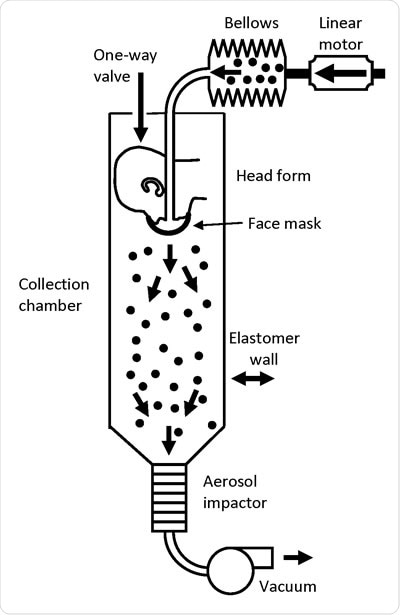Researchers from the Centers for Disease Control and Prevention (CDC) have conducted a study showing that face masks and neck gaiters appear to be much more effective than face shields at reducing the expulsion of respiratory aerosols that could potentially transmit severe acute respiratory syndrome 2 (SARS-CoV-2).
SARS-CoV-2 is the agent responsible for the current coronavirus disease 2019 (COVID-19) pandemic that continues to pose an ongoing threat to global public health and the economy.
Using a cough aerosol simulator to expel small aerosol particles into different face coverings, the team found that the N95 respirator, procedure mask, cloth mask, and neck gaiters effectively reduced the emission of the aerosols, while the face shield was not.
“Our results suggest that face masks and neck gaiters are preferable to face shields as source control devices for cough aerosols,” writes William Lindsley and colleagues.
A pre-print version of the paper is available in the server medRxiv*, while the article undergoes peer review.

Cough aerosol simulator system for source control measurements. The system consists of an aerosol generation system, a bellows and linear motor to produce the simulated cough, a pliable skin head form on which the face mask, neck gaiter or face shield is placed, a 105 liter collection chamber into which the aerosol is coughed, and an Andersen impactor to separate the aerosol particles by size and collect them.
Community transmission can occur through infected aerosol droplets
SARS-CoV-2 can be transmitted from person to person via large respiratory aerosols (diameter greater than around 10µm) that are produced when an infected person coughs, sneezes, breathes, talks, or sings.
However, smaller aerosols are also emitted during these activities, suggesting that short-range airborne virus transmission might also be possible.
To protect against this potential route of community transmission, various public health bodies, including the CDC and the World Health Organization (WHO) have recommended that the general public wear face masks or other face coverings as source control devices.
“Source control devices are intended to protect other people from infectious aerosols emitted by the wearer, as compared with personal protective equipment such as N95 respirators which are primarily intended to protect the wearer,” explains the team.
However, people often dislike wearing face masks, and compliance levels can be low and inconsistent, say the researchers.
People may repeatedly remove and replace the mask and keep adjusting it, which can contaminate the hands. This potentially leads to the transmission of the virus, particularly in cases where the masks are re-used.
Face shields were proposed as an alternative
In an opinion article in the Journal of the American Medical Association, researchers suggested that face shields may be more effective at reducing community transmission because they are more comfortable and, therefore, more likely to be widely adopted by the public.
However, few studies have examined face shields as source control devices, and quantitative data on efficacy is lacking.
What did the current study involve?
Now, Lindsley and colleagues have used a cough aerosol simulator to eject a cloud that simulates small respiratory aerosols (0 to 7µm in diameter) into different types of face coverings and assessed the quantity of particles that were able to travel through and around each device.
The researchers tested the collection efficiencies (the fraction of the aerosols blocked by the device) of an N95 respirator, a medical procedure mask, a commercial 3-ply cloth face mask, a polyester neck gaiter, and a commercial disposable face shield.
Neck gaiters are worn either as a single layer of fabric or as a folded, two-layer fabric. For the experiments carried out in this study, the researchers tested both configurations.
Face masks and gaiters were much more effective than the face shield
On average, the N95 respirator stopped 99% of the total cough aerosol being expelled into the environment, while the procedure mask blocked 59%, and the cloth face mask blocked 51%.
The neck gaiter blocked 47% of the cough aerosol when it was worn as a single layer and 60% when it was worn as a double layer.
The face shield, on the other hand, only stopped 2% of the cough aerosol being expelled into the atmosphere.
There were no significant differences in the collection efficiencies of the procedure mask, cloth mask, and neck gaiter, but all of these devices were significantly more effective than the face shield.
“Our results suggest that face coverings are more effective than face shields as source control devices to reduce the expulsion of respiratory aerosols into the environment as a public health measure to reduce the community transmission of SARS-CoV-2,” concludes the team.

 This news article was a review of a preliminary scientific report that had not undergone peer-review at the time of publication. Since its initial publication, the scientific report has now been peer reviewed and accepted for publication in a Scientific Journal. Links to the preliminary and peer-reviewed reports are available in the Sources section at the bottom of this article. View Sources
This news article was a review of a preliminary scientific report that had not undergone peer-review at the time of publication. Since its initial publication, the scientific report has now been peer reviewed and accepted for publication in a Scientific Journal. Links to the preliminary and peer-reviewed reports are available in the Sources section at the bottom of this article. View Sources